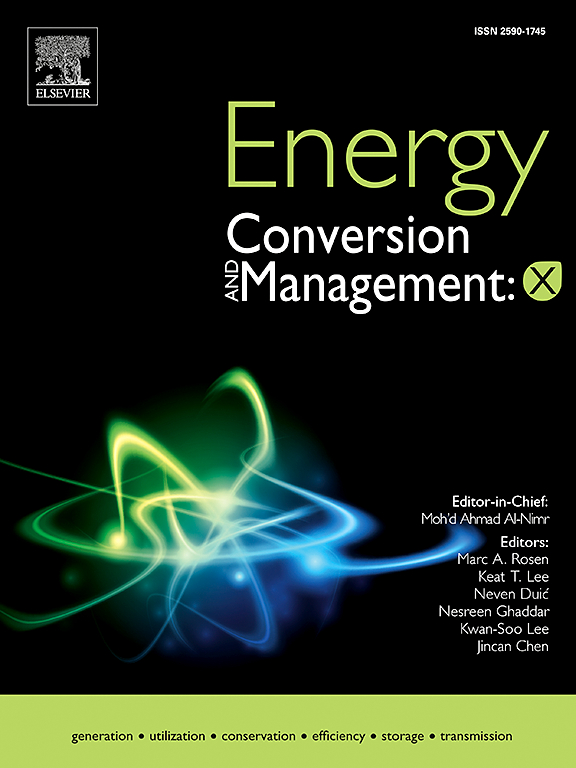不确定性和需求响应方案下可再生能源、电动汽车停车场、固定和移动电池的最优配置与配置
IF 7.1
Q1 ENERGY & FUELS
引用次数: 0
摘要
全球向可再生能源过渡对于减轻环境污染和减少对化石燃料的依赖至关重要。然而,RESs固有的间歇性给电力系统的稳定性带来了重大挑战,而电动汽车(ev)的预期增长将进一步加剧这一挑战,预计到2030年电动汽车的数量将超过1.3亿辆。为了支持这一转变,一个强大的能源基础设施是必不可少的,它集成了RESs、智能插电式电动汽车停车场(PEV-PLs)、储能系统(ess)和需求响应计划(DRPs)。本文提出了一个随机多目标混合整数非线性规划(MINLP)模型,用于研究随着RES和EV渗透率的增加,配电系统的优化规划和运行。该模型包括风力和光伏(PV)分布式发电机(dg)、PV - pls、固定和移动电池储能系统(fbess和MBESSs)以及DRPs。它可以最佳地确定关键组件的尺寸和位置,同时战略性地管理mbess的搬迁,以最大限度地降低经济成本(投资、维护和运营)、环境影响(PDS的碳排放)、功率损耗和电压偏差。该模型还考虑了主要的不确定性,包括电动汽车充电行为、风速、太阳辐照、负荷需求和能源价格波动。提出的框架使用IEEE 69总线测试系统进行验证,评估了9种配置,范围从基线(案例1)到完全集成的设置(案例9)。这些病例包括RESs、PEV-PLs、fbess、mbess和DRPs的各种组合。该分析强调了将RESs、storage和drp协调集成以实现环境和运营效益的重要性。在评估的配置中,Case 7(包括RESs、PEV-PLs、MBESSs和DRP)是最平衡的解决方案,实现了最低的排放成本(323,516.65美元/年)、最高的损耗降低(39.60%)和最大的电压偏差改善(41.14%)。案例3在降低运营成本(35.66%)和实现最高RES渗透率(2.65 MVA)方面表现出色,证明了将风能-光伏发电dg与适度的电动汽车车队相结合的好处。相比之下,案例9尽管采用了最高的电动汽车普及率(179辆)和最全面的技术组合,但由于系统复杂性,在经济上表现不佳,运营成本仅降低了16.54%,总成本增加了1.23%。总体而言,结果表明,平衡可再生能源整合与适度电动汽车部署和战略储能的配置,如案例3和案例7,在经济和环境目标之间提供了最有效的权衡。本文章由计算机程序翻译,如有差异,请以英文原文为准。
Optimal allocation and configuration of renewable energy sources, electric vehicle parking lots, and fixed and mobile batteries under uncertainty and demand response program
The global transition to renewable energy sources (RESs) is critical for mitigating environmental pollution and reducing dependence on fossil fuels. However, the inherent intermittency of RESs presents significant challenges to power system stability, which are further exacerbated by the anticipated rise in electric vehicles (EVs), projected to exceed 130 million by 2030. To support this transformation, a robust energy infrastructure that integrates RESs, smart plug-in EV parking lots (PEV-PLs), energy storage systems (ESSs), and demand response programs (DRPs) is essential. This paper proposes a stochastic multi-objective mixed-integer nonlinear programming (MINLP) model for the optimal planning and operation of distribution systems (PDS) with increasing RES and EV penetration. The model incorporates wind and photovoltaic (PV) distributed generators (DGs), PEV-PLs, fixed and mobile battery energy storage systems (FBESSs and MBESSs), and DRPs. It optimally determines the sizing and placement of key components while strategically managing the relocation of MBESSs to minimize economic costs (investment, maintenance, and operation), environmental impacts (carbon emissions from the PDS), power losses, and voltage deviations. The model also accounts for major uncertainties, including EV charging behavior, wind speed, solar irradiation, load demand, and energy price fluctuations. The proposed framework is validated using the IEEE 69-bus test system, with nine configurations evaluated, ranging from a baseline (Case 1) to a fully integrated setup (Case 9). These cases include various combinations of RESs, PEV-PLs, FBESSs, MBESSs, and DRPs. The analysis underscores the importance of coordinated integration of RESs, storage, and DRPs to achieve environmental and operational benefits. Among the evaluated configurations, Case 7, which includes RESs, PEV-PLs, MBESSs, and DRP, emerges as the most balanced solution, achieving the lowest emission cost ($323,516.65/year), the highest loss reduction (39.60%), and the greatest voltage deviation improvement (41.14%). Case 3 excels in reducing operational costs (35.66%) and achieving the highest RES penetration (2.65 MVA), demonstrating the benefits of combining wind-PV DGs with a moderate EV fleet. In contrast, Case 9, despite incorporating the highest EV penetration (179 EVs) and the most comprehensive mix of technologies, underperforms economically due to system complexity, with only a 16.54% reduction in operational costs and a 1.23% increase in total cost. Overall, the results indicate that configurations that balance RES integration with moderate EV deployment and strategic energy storage, such as Cases 3 and 7, offer the most effective trade-offs between economic and environmental objectives.
求助全文
通过发布文献求助,成功后即可免费获取论文全文。
去求助
来源期刊

Energy Conversion and Management-X
Multiple-
CiteScore
8.80
自引率
3.20%
发文量
180
审稿时长
58 days
期刊介绍:
Energy Conversion and Management: X is the open access extension of the reputable journal Energy Conversion and Management, serving as a platform for interdisciplinary research on a wide array of critical energy subjects. The journal is dedicated to publishing original contributions and in-depth technical review articles that present groundbreaking research on topics spanning energy generation, utilization, conversion, storage, transmission, conservation, management, and sustainability.
The scope of Energy Conversion and Management: X encompasses various forms of energy, including mechanical, thermal, nuclear, chemical, electromagnetic, magnetic, and electric energy. It addresses all known energy resources, highlighting both conventional sources like fossil fuels and nuclear power, as well as renewable resources such as solar, biomass, hydro, wind, geothermal, and ocean energy.
 求助内容:
求助内容: 应助结果提醒方式:
应助结果提醒方式:


